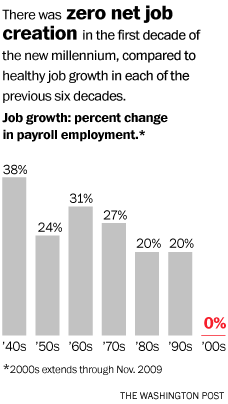The decade that just ended saw no growth in the number of jobs in the US. Every previous decade since the 1940s had produced at least a 20 percent increase in payroll employment.

And after increasing by 42 percent in the 1980s and 58 percent in the 1990s, household net worth (adjusted for inflation) declined by 4 percent in the 2000s, The Washington Post reported.
The miserable economic track record is, in part, a quirk of timing. The 1990s ended near the top of a stock market and investment bubble. Three months after champagne corks popped to celebrate the dawn of the year 2000, the market turned south, a recession soon following. The decade finished near the trough of a severe recession.
But beyond these dramatic ups and downs lies an even more sobering reality: long-term economic stagnation. The trillions of dollars that poured into housing investment and consumer spending in the first part of the decade distorted economic activity.
Capital was funneled to build mini-mansions in Sun Belt suburbs, many of which now sit empty, rather than toward industrial machines or other business investment that might generate economic output and jobs for years to come.
For all the talk about how the US is replacing its manufacturing-based economy with an information- and service-based economy, it’s not just the old industrial jobs that are being outsourced.
As the New York Times reported in 2003, it’s “new jobs” too.
With American corporations under increasing pressure to cut costs and build global supply networks, two senior I.B.M. officials told their corporate colleagues around the world in a recorded conference call that I.B.M. needed to accelerate its efforts to move white-collar, often high-paying, jobs overseas even though that might create a backlash among politicians and its own employees.
During the call, I.B.M’s top employee relations executives said that three million service jobs were expected to shift to foreign workers by 2015 and that I.B.M. should move some of its jobs now done in the United States, including software design jobs, to India and other countries.
“Our competitors are doing it and we have to do it,” Tom Lynch, I.B.M.’s director for global employee relations, said in the call. A recording was provided to The New York Times recently by the Washington Alliance of Technology Workers, a Seattle-based group seeking to unionize high-technology workers. The group said it had received the recording — which was made by I.B.M. and later placed in digital form on an internal company Web site — from an I.B.M. employee upset about the plans.
And last year, word leaked that IBM would cut about 5,000 US jobs and send the work to India– where, of course, tech workers are paid far less for the same work.
As Time reported:
The IBM news is troubling because labor costs in the U.S., even among highly educated adults, are falling. American workers should be available for employment at salaries much lower than they were two years ago. But, it appears that IBM has elected to move jobs offshore rather than keep them in the U.S. despite the trend of more tech workers losing their jobs here.
But, the cost of labor in India, which was already below that in the U.S., is likely to be falling even faster than it is in the U.S. The outsourcing business in India has been hit with a sharp drop in demand, and the major Indian employers in the sector are doing poorly.
…IBM clearly arbitraged the joblessness in the U.S. and India as it made its decision about where to employ several thousand people. To put it crassly, IBM is looking for the equivalent of the lowest cost bidder.
The AFL-CIO responds to some of the corporate claims about the harmlessness and benefits to Americans of offshore outsourcing.